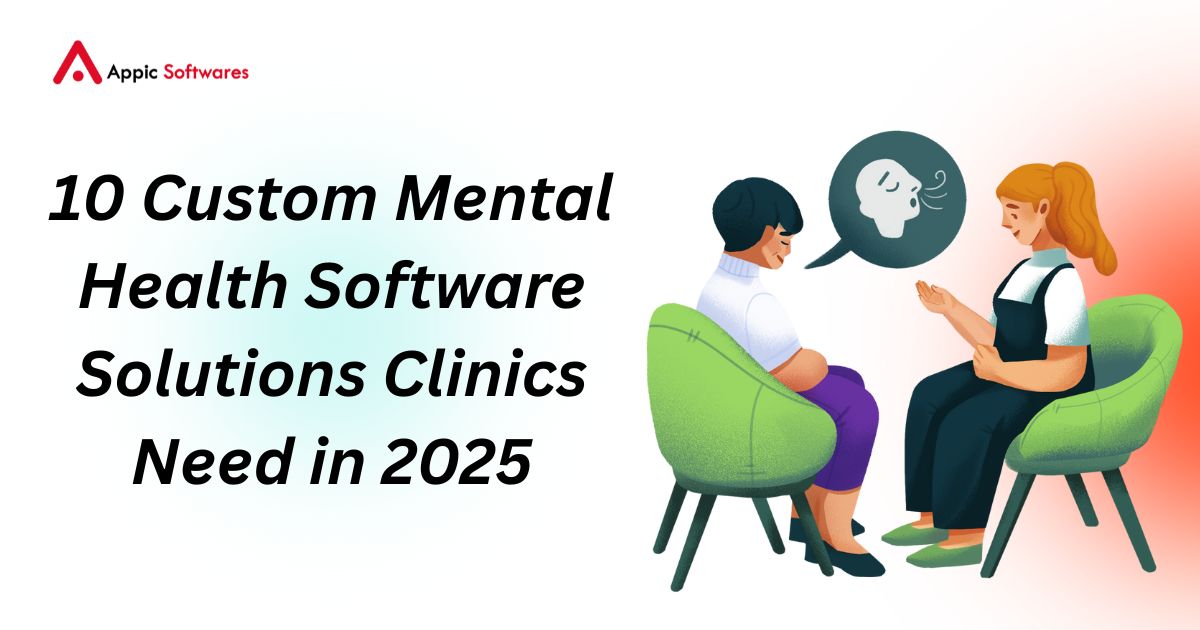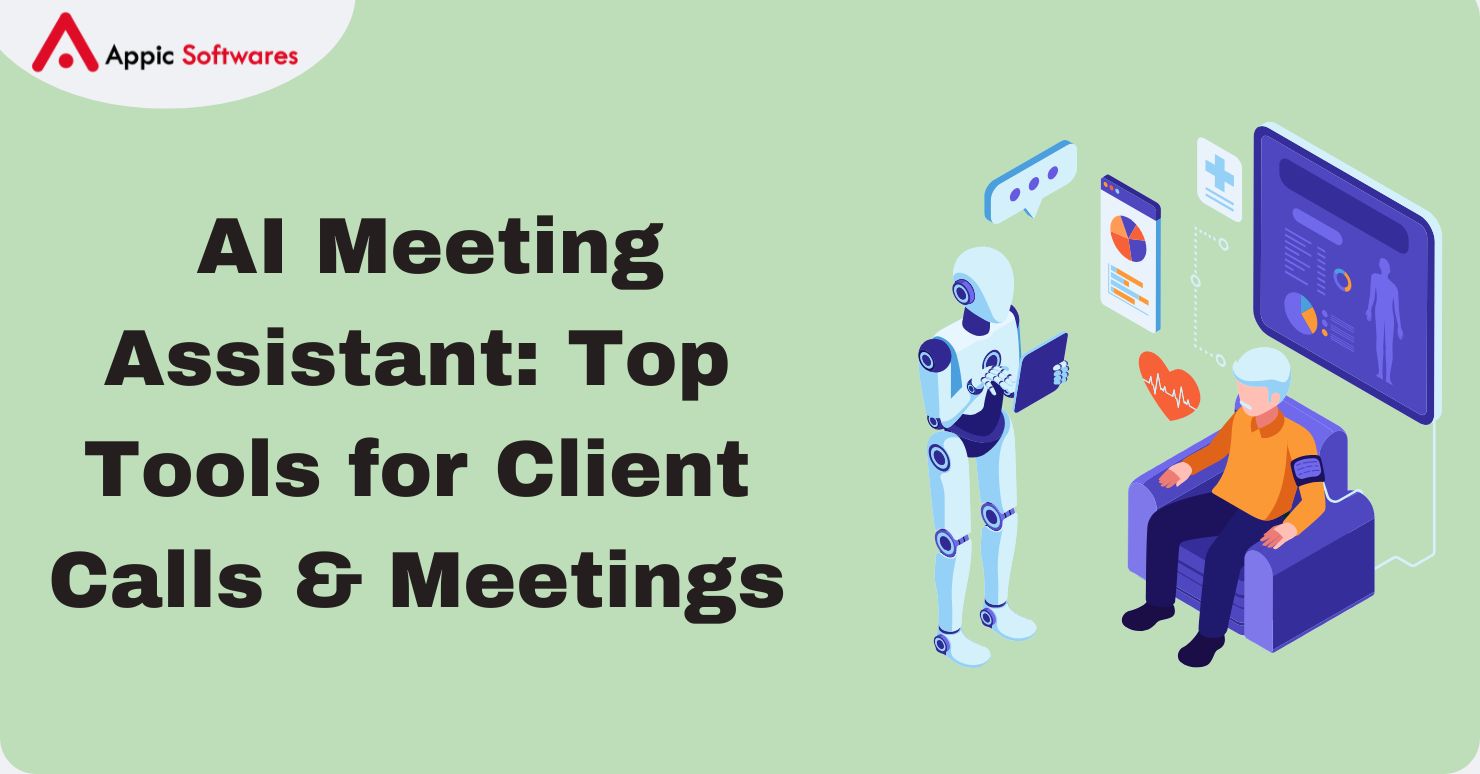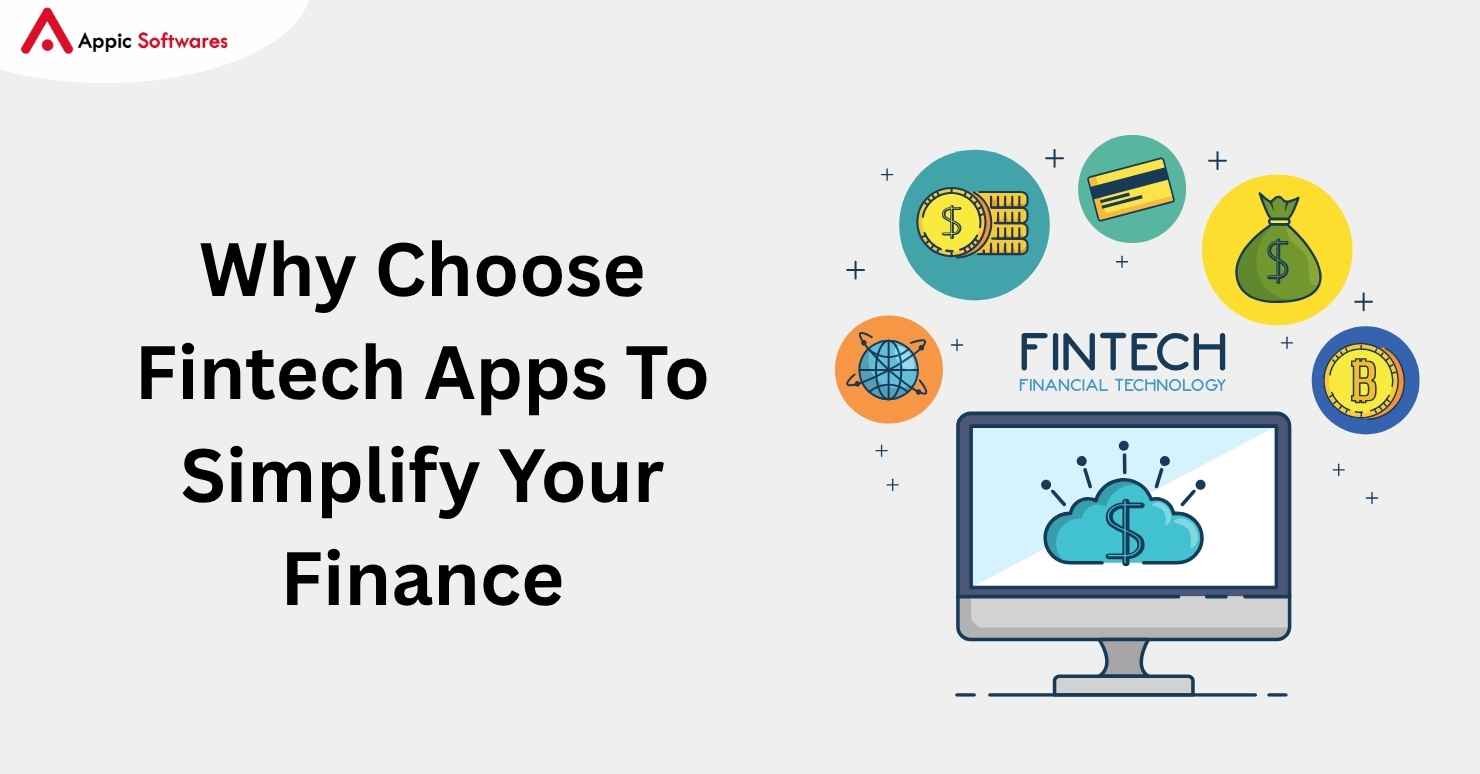
The global EdTech market is experiencing substantial growth, with the market size estimated to reach USD 721.15 billion by 2033, exhibiting an 11.86% CAGR between 2025 and 2033. Education in the United States is going through a big change. Many schools now use technology to improve learning. Custom EdTech apps help teachers, students, and school staff work better. These apps are made to fit the needs of school districts. In this article, we will explain what features a good EdTech app should have and how much it costs to build one.
Why Custom EdTech Apps Are Needed
Each school district is different. They have different rules, goals, and student needs. A ready-made app may not solve their problems. That is why custom apps are better. They can be designed to match the exact needs of each district.
With features like AI agents in education, these apps can offer personalized learning paths, automate routine tasks, and even provide real-time academic support. They help teachers track student progress and let students learn at their own speed. They give school administrators better control and insights, and also make it easy for parents to stay updated.
Important Features of a Custom EdTech App
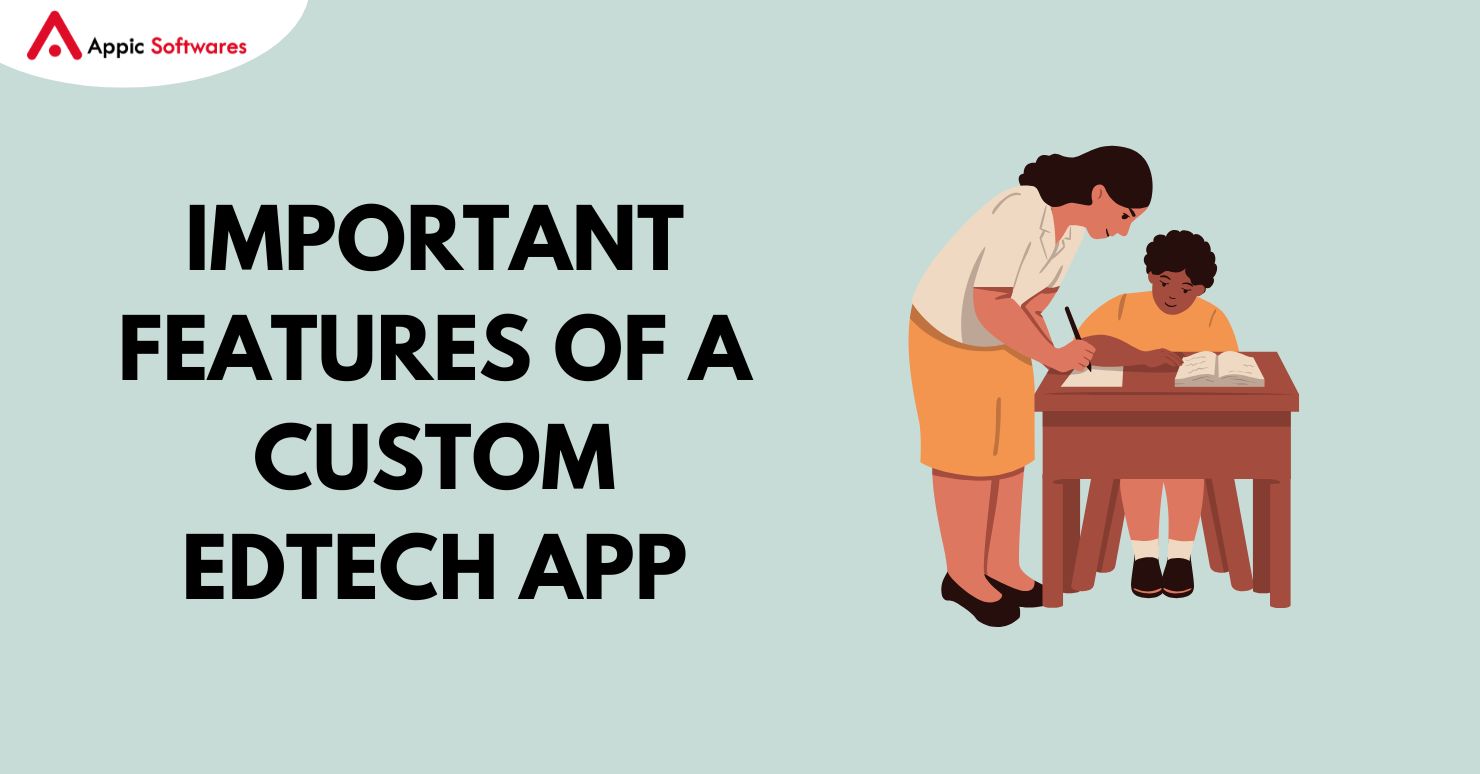
When building an EdTech app, you must include the right features. The app must work well for students, teachers, parents, and admins. Let’s look at the most important features in detail.
User Management
This is the most basic feature. The app must let users create and manage their accounts. Each user should have a role. Students, teachers, parents, and administrators should see different things based on their role. Login should be easy and secure. Single sign-on (SSO) is a good option.
Interactive Learning Tools
The app should allow students to watch videos, read notes, and complete activities. It should also support quizzes, games, and practice tests. Students learn better when they are engaged. The app should support all types of content like text, images, videos, and animations.
Assignments and Homework
Teachers should be able to upload homework and assignments. Students should be able to submit them using the app. Teachers should then check and grade them inside the app. This makes the process fast and easy.
Performance Tracking
One of the best parts of an EdTech app is tracking. Teachers can track how well students are doing. Parents can see how their children are performing. School admins can check the overall reports. The app should have clear dashboards with graphs and charts.
Communication Tools
Good communication helps everyone stay on the same page. The app should let teachers send messages to students and parents. It should support announcements and push notifications. There should also be options for in-app chat or discussion forums.
Live Classes and Video Support
In today’s world, live classes are very useful. The app should allow teachers to take classes using video. It should also support recording and playback. This helps students who missed the class or want to revise. To build this effectively, it’s best to collaborate with an experienced LMS development company. They can integrate robust live streaming features, ensure smooth performance across devices, and add functionalities like chat, screen sharing, and session recording.
Calendar and Scheduling
A shared calendar is helpful. Teachers can add class schedules, test dates, and events. Students and parents can see all important dates. It keeps everyone informed.
Parent Access and Involvement
Parents should have access to their child’s progress. They should see grades, attendance, homework, and teacher feedback. This helps them stay involved and support their children.
Data Privacy and Security
School data is very sensitive. The app must follow U.S. laws like FERPA and COPPA. Data must be encrypted. Only the right people should access the data. This keeps students safe.
Offline Access
Some students may not always have internet. The app should work offline. Students can download content and access it without internet. This helps in remote areas.
Multi-Language Support
Many students and parents speak different languages. The app should support more than one language. This makes it easier for everyone to use.
Integration with School Systems
The app must work with the school’s other systems. These include Student Information Systems (SIS), Learning Management Systems (LMS), and grading tools. This saves time and avoids double work.
How Much Does It Cost to Build a Custom EdTech App?
The cost of building an EdTech app depends on many things. The total cost is based on features, design, technology, and team size. Let’s break it down.
Cost Based on App Type
A simple app with basic features may cost between $20,000 to $50,000. These include features like student login, quiz tools, and simple tracking.
A medium-level app with video lessons, live classes, and progress dashboards may cost between $50,000 to $100,000.
A high-end app with AI-based learning, gamification, and deep analytics may cost $100,000 to $300,000 or more.
Read more: How Much Does It Cost To Create An App
Team Structure And Development Cost
You will need a team to build your app. The team may include:
- Project Manager
- UI/UX Designer
- Mobile App Developer (Android and iOS)
- Backend Developer
- QA Tester
If you hire a team in the U.S., the cost will be higher. Hiring an offshore team from India or Eastern Europe may lower the cost.
Platform Choice
Do you want the app on iOS, Android, or both? If you build for one platform, the cost is lower. If you want both, the cost is higher. Using cross-platform tools like Flutter or React Native can reduce the cost.
Third-Party Integrations
You may need to add third-party tools. These include video calling APIs, analytics tools, or cloud storage. Some of these tools are free. Others need paid subscriptions. These add to the total cost.
Maintenance and Updates
Building the app is just the start. You will need to maintain it. You will need to fix bugs, update features, and improve security. Maintenance may cost 15% to 20% of the initial app cost per year.
Other Costs to Consider
Hosting is another cost. You need cloud servers to run your app. This cost depends on traffic and storage. You will also need to spend on design. A good UI/UX is important. Users will only enjoy using the app if the design is easy and clean. You may need a marketing budget too. Schools need to know about your app. You may need to show demos, run ads, or attend expos.
To streamline this entire process, it’s smart to work with an experienced education app development company. They’ll help you balance functionality, compliance, and performance while making sure your app stands out in a crowded market.
| Scope | Features | Estimated Cost |
|---|---|---|
| Basic | Quizzes, progress tracking, simple UI | $10,000-30,000 |
| Moderate | Multimedia, profiles, push notifications, analytics | $30,000-60,000 |
| Advanced | AI-driven personalization, live classes, gamification | $60,000-$80,000 |
Challenges In EdTech App Development
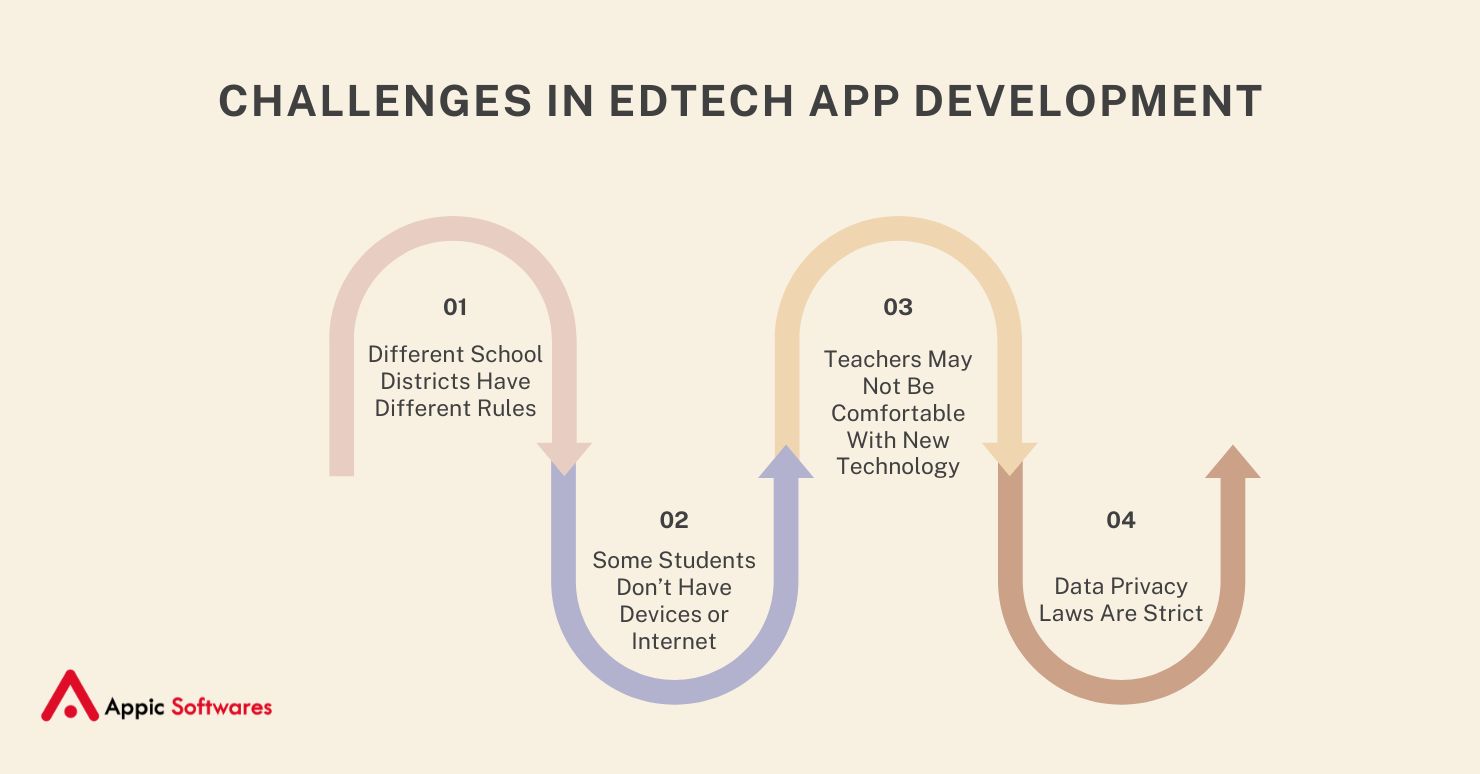
Different School Districts Have Different Rules
Every school district in the U.S. operates differently. They follow unique policies regarding the use of EdTech apps. Some districts are quick to adopt new technology, while others are slower due to budget concerns or approval processes. This means that EdTech app development must be flexible. Developers should be ready to customize the app based on local rules, educational goals, and available tools.
For example, one district may require integration with K12 student information systems like PowerSchool or Infinite Campus, while another may not. Others may have rules for storing student data only on U.S.-based servers. These variations make it necessary to build a custom K-12 education technology solution for each school or region.
Understanding these differences early helps avoid issues later. Before starting development, it’s important to study district policies and build the app to meet those standards.
Some Students Don’t Have Devices or Internet
Even today, not all students have access to the internet or digital devices. This is especially true for students in rural or low-income areas. A well-designed EdTech app should support offline use. That means students can download lessons when they’re online and access them later without an internet connection.
This is critical for the success of K-12 education technology, which must serve every child, not just those in cities with high-speed internet. The app should also work on low-end smartphones and tablets. A lightweight, fast app ensures no student is left behind.
Providing offline support also adds value to the budget for EdTech application because it ensures that a single app can serve a wider range of student needs, without requiring extra tools or support.
Teachers May Not Be Comfortable With New Technology
Many teachers are not trained to use advanced educational tools. This is a major concern in EdTech app development. Even if your app has great features, it won’t be used if it feels confusing or overwhelming to teachers.
The solution is to focus on user experience. EdTech apps must have simple interfaces with clear navigation. Built-in tutorials, video guides, and customer support should be included. It’s also important that the app reduces workload instead of adding to it. Automating grading, sending alerts, and syncing with calendars can save time.
Involving teachers during the design stage also helps. If they feel the app meets their daily needs, they’ll be more likely to use it. This not only boosts engagement but also helps schools get better returns on their budget for EdTech application.
Data Privacy Laws Are Strict
Protecting student data is a legal requirement in the U.S. K-12 education technology must follow strict laws like FERPA and COPPA. These laws require developers to be extremely careful with how student information is collected, stored, and shared.
Any EdTech app that collects personal details must use encryption and secure login systems. Parents should have the ability to review and delete data. Schools must have full control over user permissions and access.
This is especially important when integrating with K12 student information systems, where sensitive data like grades, attendance, and student profiles are stored. Compliance not only keeps schools safe from legal issues but also builds trust in the product.
How To Start Building A Custom EdTech App
First, study what your school district needs. Make a list of problems you want to solve. Talk to teachers, students, and parents. Next, prepare a basic idea or prototype. Show this to others and get feedback. Make changes as needed.
Then, hire developers. Share your goals clearly. Start with a Minimum Viable Product (MVP). This is a simple version of the app with core features. Launch it and collect feedback. Later, add more features.
Always test the app well. It should work on all devices and should be fast and safe.
Conclusion
Custom EdTech apps are changing how U.S. school districts teach and manage learning. They help students learn better. They save time for teachers. To build a good app, you must include the right features. You must follow safety rules. And you must test it well.
Costs can range from $10,000 to $80,000 based on features and design. But the benefits are much greater. A custom app can improve learning for thousands of students.
If you are planning to build an EdTech app, start small. Focus on key needs. Grow slowly. And work with experts who understand both education and technology. Partner with Appic Softwares, the industry leader in building secure, scalable, and future-ready educational apps. Our team combines deep expertise in both education and technology, including the use of AI agents in learning, to create solutions that truly make a difference.
Let’s build the future of learning together. Get in touch with us now.
FAQs
1. How long does it take to build a custom EdTech app?
The development timeline depends on the app’s features and complexity. A basic EdTech app may take 2–3 months to build. A medium or advanced-level app with AI features, live classes, and full integration with K12 student information systems may take 4–8 months or longer. The timeline also depends on your development team’s speed and the feedback process from your school district.
2. Can the app be customized for different school districts?
Yes. Custom EdTech app development is designed to meet the unique needs of each school district. This includes adjusting features, user roles, language support, compliance with district-specific rules, and integration with existing systems like SIS or LMS. Each app can be tailored to match local goals, user workflows, and privacy policies.
3. Is it possible to add AI-powered features later?
Absolutely. You can start with a basic version (MVP) and add AI-driven EdTech app features later. For example, after launch, you can integrate AI agents for personalized learning paths, automated feedback, or performance analytics. Working with an experienced team ensures your app is scalable and future-ready, allowing you to adopt AI in education when you’re ready. When the time comes, you can also hire AI engineers to implement advanced features that enhance the learning experience and improve outcomes.







